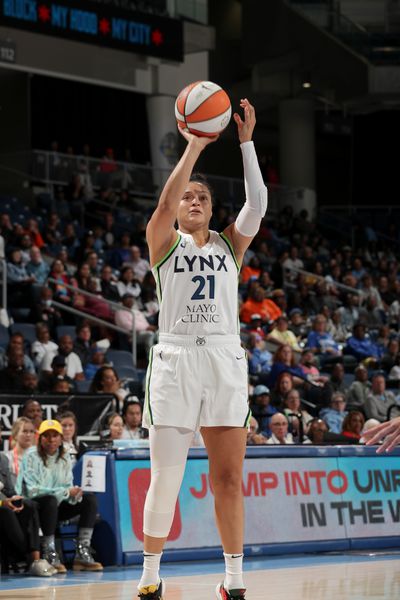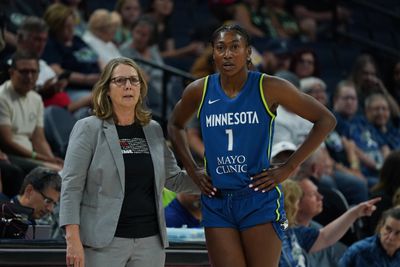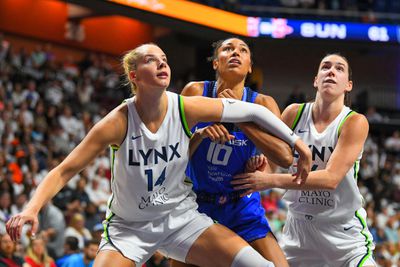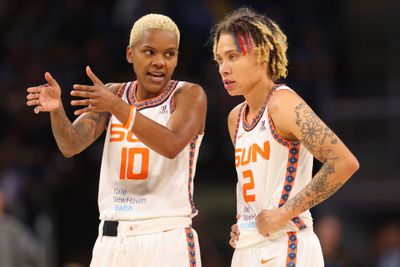
The Minnesota Lynx had a surprisingly successful 2023 season, but they won’t be sneaking up on anyone in 2024. We’ll see if their offseason acquisitions will be enough to get them back over .500.
The Minnesota Lynx were one of the WNBA’s surprise teams in 2023, overcoming an 0-6 start to the season to finish 19-21 and earn the sixth seed in the WNBA playoffs. What many expected to be a rebuilding season for a proud Minnesota franchise turned out to be a competitive and exciting one instead, though it changed the Lynx’ trajectory heading into 2024—no one will be sleeping on them this time around.
The Lynx were busy in free agency, adding several veteran pieces to their rotation, but how will each of them fit? Can Minnesota’s new additions get the team back above .500 and into contention status? Here are a few reasons to believe in the Lynx in 2024, along with some reasons to be cautious.
Reasons to like the Lynx in 2024
Napheesa Collier is one of the best players in the WNBA

Photo by M. Anthony Nesmith/Icon Sportswire via Getty Images
2023 was a breakout season for Collier, who took the leap to become a full-fledged star in her first year as Minnesota’s unquestioned go-to player. Collier averaged a career-high 21.5 points per game (fourth in the WNBA) along with 8.5 rebounds, 1.6 steals and 1.2 blocks per game, earning her third All-Star appearance and first All-WNBA First Team honor.
Expect more of the same from Collier in 2024. She’s one a handful of WNBA players who produce at a star level on both ends of the court. Statistically, Collier’s scoring stands out (especially in 2023, when she posted a career-high 28.1 percent usage rate), but she’s also one of the league’s most effective and versatile defenders. According to the Across the Timeline database, Collier was the only player in the WNBA to record at least one block and 1.5 steals per game in 2023, and her ability to defend at a high level everywhere on the court gives the Lynx a luxury that not many other teams enjoy.
The Lynx have considerable depth on the perimeter

Photo by Gary Dineen/NBAE via Getty Images
Collier is surrounded by a group of dependable wing players, giving the Lynx reliable depth at both shooting guard and small forward. Kayla McBride and Bridget Carleton will return as Minnesota’s steady hands, while second-year player Diamond Miller adds length and athleticism to the group. Cecilia Zandalasini will also return to Minnesota to play her first WNBA season since 2018.
While Miller’s status is uncertain after an offseason knee procedure, the team knows exactly what it’s getting from McBride, Carleton and Zandalasini. McBride, in particular, has been one of the WNBA’s best 3-point shooters for years, and in three seasons in Minnesota she’s averaged 13.8 points per game.
Carleton (a 36.6 percent career 3-point shooter) and Zandalasini (38.3 percent) have been lower-volume players throughout their respective careers, but their presence all but guarantees that Minnesota can field lineups with multiple wing players who can shoot the long ball, allowing head coach Cheryl Reeve to mix and match them with Miller and McBride. It’s hard to win in today’s WNBA if you can’t space the floor, but that shouldn’t be an issue for the Lynx this season.
Minnesota has a strong veteran presence

Photo by Jordan Johnson/NBAE via Getty Images
Aside from second-year players Miller and Dorka Juhász and rookie Alissa Pili, the Lynx roster is loaded with players who have been around the league for a while. It won’t be a late-2010s Lynx dynasty team, of course, but with six of Minnesota’s projected rotation players having at least five years of WNBA experience, the Lynx will have a nice balance of veterans and youngsters.
Minnesota’s wealth of WNBA experience extends to its coaching staff, too. In what will be her 15th season at the helm of the Lynx, Cheryl Reeve is by far the league’s longest-tenured head coach, and she’s flanked by a pair of all-time greats in Naismith Basketball Hall of Famer Katie Smith and five-time WNBA champion Rebekkah Brunson. Also serving on Reeve’s coaching staff is Elaine Powell, who played in the WNBA from 1999 through 2008.
Reasons for concern about the Lynx in 2024
Minnesota may lack depth in the frontcourt

Photo by Erica Denhoff/Icon Sportswire via Getty Images
For as solid as the Lynx are on the perimeter, there’s not nearly as much certainty as to what their frontcourt will look like. It’s a safe bet that Juhász, who averaged six points and 6.5 rebounds per game last season and was named to the WNBA’s All-Rookie team, will start, and Alanna Smith, who the Lynx signed to a two-year deal in free agency, will play a prominent role as well, but there’s at least one spot up front that has yet to be decided.
Ruthy Hebard and Sika Koné, both of whom played for the Chicago Sky last season, are competing in Minnesota’s training camp. Pili, who the Lynx just drafted at No. 8 overall, is also in the mix, and she’s likely to make the team. Taylor Soule, Mimi Collins and Camryn Taylor round out the list of frontcourt players competing to make Minnesota’s final roster.
There’s no obvious backup for Juhász among them, though. Hebard brings efficient scoring out of the pick-and-roll and Koné offers youthful energy when working the boards, but the jury is still out on if either will be trusted as a defensive stopper in Minnesota. Pili, while undoubtedly skilled offensively, is generously listed at 6-foot-2 and may have a hard time earning big minutes right away as she adjusts to the WNBA game.
Whoever earns that final spot in Minnesota’s frontcourt will need to bring their A-game on the defensive end of the court. Last season, the Lynx ranked eighth in the WNBA in points allowed in the paint per game (36.7) and 10th in both defensive rebounding rate (70.1 percent) and defensive efficiency (105.7 points allowed per 100 possessions).
The Lynx have a brand-new point guard rotation

Photo by Michael Reaves/Getty Images
Minnesota’s other offseason acquisitions included guards Courtney Williams, who signed a two-year contract with the Lynx, and Natisha Hiedeman, who Minnesota traded Tiffany Mitchell for. Williams has earned a reputation as a midrange shooting specialist throughout her eight years in the WNBA, while Hiedeman was an integral piece of a Connecticut Sun franchise that won 25 or more games in each of the past three seasons.
Neither player is considered to be a natural point guard, however, and there’s precious few days in training camp before the games start for real. Right now, we don’t even know which of Williams or Hiedeman will be starting for the Lynx, let alone how effective they’ll be in their first season with the team. It’s entirely possible that both players excel in their new roles, but don’t be surprised if there’s an adjustment period at the start of the season, either.







